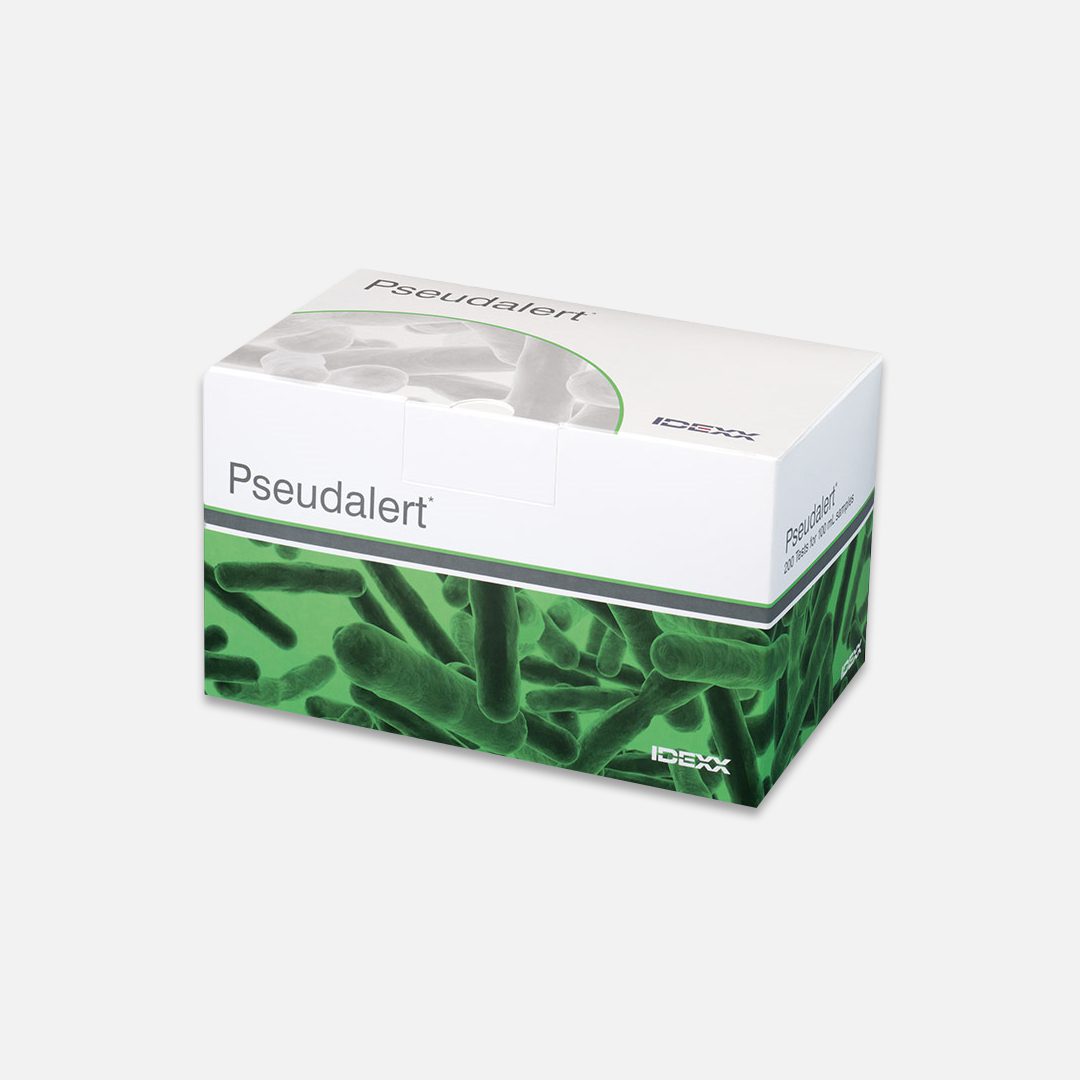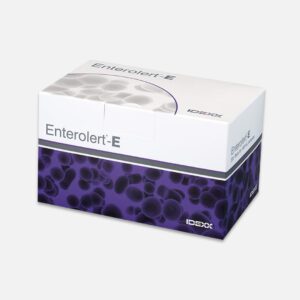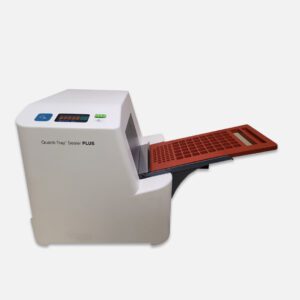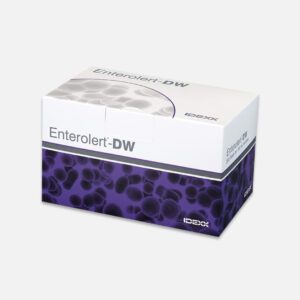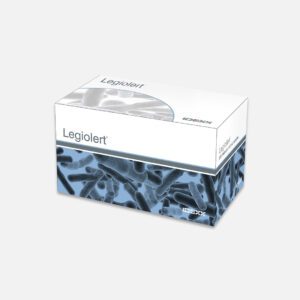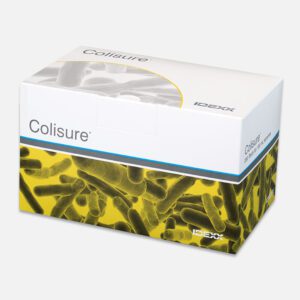Description
Overview
Easy
- Blue fluorescence of wells or vessel indicates a positive result.
- Same familiar platform as the Colilert Test:
- Ready-to-use reagents, no media preparation.
- Convenient unit-dosed packaging.
- No toxic compounds.
- Use with Quanti-Tray or Quanti-Tray/2000 for most probable number (MPN) enumeration.
Rapid
- Definitive results in 24 hours.
- Less than 1 minute of hands-on time for streamlined testing work flow.
Accurate
- Specifically detects Pseudomonas aeruginosa, reducing the risk of false positives from nontarget organisms.
- Results are definitive without additional confirmation steps.
- Simple blue fluorescent change minimizes subjective result interpretation.
Science
How the Pseudalert Test works
The Pseudalert Test detects the presence of Pseudomonas aeruginosa in water samples.The test is based on a bacterial enzyme detection technology that signals the presence of P. aeruginosa through the hydrolysis of a substrate in the Pseudalert reagent. P. aeruginosa cells rapidly grow and reproduce using the rich supply of amino acids, vitamins, and other nutrients present in the Pseudalert reagent. Actively growing strains of P. aeruginosa have an enzyme that cleaves the substrate in the reagent to produce blue fluorescence under ultraviolet light.
Pseudalert detects Pseudomonas aeruginosa at 1 cfu per 100 mL water sample within 24 hours.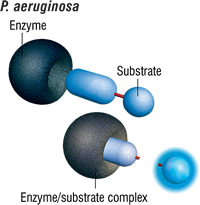
How to use
Presence/Absence (P/A)
Step 1
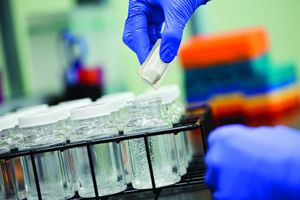 Add reagent to sample (sample will turn yellow), and then incubate at 38°C±0.5°C for 24–28 hours.
Add reagent to sample (sample will turn yellow), and then incubate at 38°C±0.5°C for 24–28 hours.
Step 2
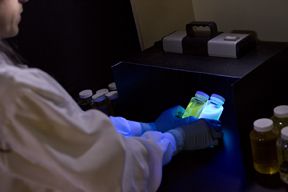 Read under ultraviolet (UV) light. Blue fluorescence indicates presence of P. aeruginosa. See the Pseudalert Quick Reference Guide (PDF) for tips on reading fluorescence.
Read under ultraviolet (UV) light. Blue fluorescence indicates presence of P. aeruginosa. See the Pseudalert Quick Reference Guide (PDF) for tips on reading fluorescence.
Quantification
Step 1
 Add reagent to sample (sample will turn yellow).
Add reagent to sample (sample will turn yellow).
Step 2
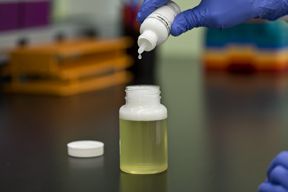 Add IDEXX Antifoam Solution to vessel.
Add IDEXX Antifoam Solution to vessel.
Step 3
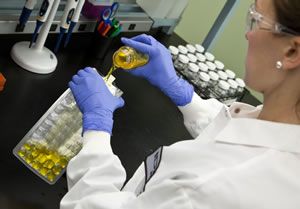 Pour sample into Quanti-Tray (counts from 1–200) or Quanti-Tray/2000 (counts from 1–2,419).
Pour sample into Quanti-Tray (counts from 1–200) or Quanti-Tray/2000 (counts from 1–2,419).
Step 4
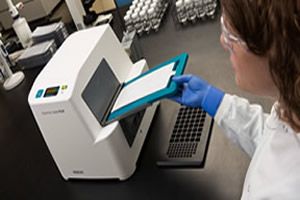 Seal using a Quanti-Tray Sealer, and then incubate at 38°C ± 0.5°C for 24–28 hours.
Seal using a Quanti-Tray Sealer, and then incubate at 38°C ± 0.5°C for 24–28 hours.
Step 5
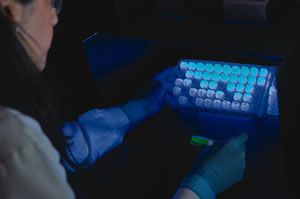 Read under ultraviolet (UV) light. Blue fluorescence indicates the presence ofP. aeruginosa. Count the positive (blue fluorescent) wells and refer to MPN table. See the Pseudalert Quick Reference Guide (PDF) for tips on reading fluorescence.
Read under ultraviolet (UV) light. Blue fluorescence indicates the presence ofP. aeruginosa. Count the positive (blue fluorescent) wells and refer to MPN table. See the Pseudalert Quick Reference Guide (PDF) for tips on reading fluorescence.
Frequently asked questions
What water types can be tested with the Pseudalert Test?
The Pseudalert Test is designed for water samples including bottled, pool, and spa water. Bottled water samples are defined as samples taken from any point in the manufacturing of bottled water (from the original water to the finished product). Extensive studies were done on Pseudomonas aeruginosa stressed by the various chemicals and cleaning agents used in pools and spas to mimic the impact of treatment. The Pseudalert Test was specifically formulated and tested to ensure it would detect stressed P. aeruginosa in these samples.
How does the Pseudalert Test work?
The Pseudalert Test is based on a bacterial enzyme detection method that signals the presence of Pseudomonas aeruginosa through the hydrolysis of an enzyme substrate. P. aeruginosa cells rapidly grow and reproduce using the rich supply of amino acids, vitamins, and other nutrients present in the Pseudalert reagent. Actively growing strains of P. aeruginosa have an enzyme that cleaves the substrate in the reagent to produce blue fluorescence under ultraviolet light. The Pseudalert Test detects P. aeruginosa at 1 cfu per 100 mL or 250 mL sample within 24 hours.
Why does the Pseudalert Test detect only Pseudomonas aeruginosa and not other Pseudomonas species?
Pseudomonas aeruginosa is the only Pseudomonas species known to cause health issues. For this reason, regulations in many countries apply specifically to P. aeruginosa detection.
What is the detection limit of the Pseudalert Test?
The Pseudalert Test detects Pseudomonas aeruginosa at 1 cfu/100 mL or 1 cfu/250 mL.
Is there a comparator for the Pseudalert Test?
There is no comparator for the Pseudalert Test. For comparison, use a negative control when interpreting results.
What is the incubation time and temperature for samples tested with the Pseudalert Test?
Water samples are incubated at 38°C ± 0.5°C for 24 hours, and results are valid up to 28 hours.
Can I incubate at a temperature other than the recommended 38°C?
No. Breakthrough of nontarget organisms can occur at temperatures other than 38°C ± 0.5°C.
Are results valid prior to 24 hours?
Yes, if the results are positive. An inoculated Pseudalert presence/absence sample that is positive for Pseudomonas aeruginosa before 24 hours is a confirmed positive test for P. aeruginosa. However, for an accurate quantitative determination of P. aeruginosa in a sample, the results should be read at 24–28 hours of incubation.
Are results valid after 28 hours?
Yes, if the results are negative. If an inoculated Pseudalert Test sample is inadvertently incubated for over 28 hours, lack of blue fluorescence is a valid negative test result. However, blue fluorescence that develops after 28 hours is not a valid positive test result; the test should be repeated or verified.
Can either a 51-well Quanti-Tray or a 97-well Quanti-Tray/2000 be used with the Pseudalert Test?
Yes, both the Quanti-Tray and Quanti-Tray/2000 can be used with the Pseudalert Test in the 100 mL format but not the 250 mL format.
What vessels should I use with the Pseudalert Test?
For presence/absence testing, use a sterile, transparent, nonfluorescing vessel. For the Quanti-Tray and Quanti-Tray/2000 systems, any sterile vessel can be used.
What are the recommended storage conditions for the Pseudalert Test?
Store Pseudalert at 2–30°C away from light.
What color and consistency should the Pseudalert reagent powder be?
The Pseudalert reagent powder should be tan in color and free-flowing. If you have any concerns about the color or integrity of the powder, contact IDEXX Technical Services.
Why is antifoam solution needed when testing samples with the Pseudalert Test in the Quanti-Tray or Quanti-Tray/2000?
The mixing of sample and reagent can create foaming. IDEXX Antifoam Solution is needed to help the foaming subside before sealing the sample in the Quanti-Tray or Quanti-Tray/2000.

